Free Mulch Sources Near You: Where to Find & How to Use Them
🌿 Did you know that 95% of the best mulch materials end up in landfills or burn piles every year? Instead of paying 5–10 per bag for mulch, you can access high-quality, nutrient-rich soil covers for free—if you know where to look! From community compost programs to overlooked urban resources, this guide reveals 12 unexpected mulch sources that will save you hundreds while supercharging your garden’s health.
According to a 2023 USDA Agricultural Research Service study, using free local mulch can:
✔ Reduce water needs by 50% compared to bare soil
✔ Increase crop yields by 35% through improved soil biology
✔ Save $200+ annually for the average gardener
Meanwhile, EPA data shows that 30 million tons of compostable yard waste go to landfills annually—waste that could become your garden’s perfect mulch. Ready to tap into these free resources?
6 Best Free Mulch Sources (With Collection Tips)
1. Municipal Leaf Collection Piles 🍂
📍 Where: City recycling centers, roadside leaf piles (autumn)
🚛 How to Get It: Most cities offer free self-serve pickup (call Public Works to confirm)
🌱 Best For: Berry patches, acid-loving plants like blueberries
Pro Tip: Shred leaves with a lawnmower first—they decompose 3x faster (RHS Trials).
Case Study: A Michigan gardener mulched her entire 1/4-acre garden using only her town’s fall leaf dump.
2. Coffee Grounds from Cafés ☕
📍 Where: Starbucks, local coffee shops (ask for "used grounds")
📦 How to Get It: Most save them in 5-gallon buckets for gardeners
🌱 Best For: Acidifying soil for roses, azaleas, and carrots
⚠️ Important: Always mix with brown materials (leaves, paper) to prevent compaction.
3. Arborist Wood Chips 🌳
📍 Where: Tree trimming companies (search "free chip delivery" on Craigslist)
🚚 How to Get It: Many will dump a truckload at your property for free
🌱 Best For: Paths, fruit tree circles, and erosion control
🔬 Science Note: Fresh chips temporarily tie up nitrogen—use them on top of compost (Journal of Agricultural Science).
4. Straw/Hay from Farmers 🌾
📍 Where: Livestock farms, equestrian centers (ask for moldy bales)
💰 How to Get It: Often free—farmers can’t feed spoiled hay to animals
🌱 Best For: Vegetable gardens (watch for weed seeds in hay)
Regional Tip: In dry climates (AZ, NV), straw reduces soil temps by 15°F.
5. Newspaper/Corrugated Cardboard 📰
📍 Where: Recycling bins, office buildings (avoid glossy prints)
✂️ How to Use: Layer 6 sheets thick, wet thoroughly, then top with compost
🌱 Best For: Smothering weeds in new beds
📊 Stats: A Rodale Institute study found cardboard mulch blocks 99% of weeds for 6+ months.
6. Seaweed (Coastal Areas Only) 🌊
📍 Where: Public beaches (check local harvesting laws)
🧂 How to Prep: Rinse salt off, then apply fresh or compost first
🌱 Best For: Boosting micronutrients—contains 60+ trace minerals
Bonus: Deters slugs naturally!
How to Use Free Mulch Like a Pro
Layer Like a Lasagna (Sheet Mulching)
- Weed area lightly
- Layer cardboard/newspaper
- Add 2–4" of green/brown materials
- Top with 1" compost (optional)
⏳ Decomposition Time:
• Leaves: 2–6 months
• Wood chips: 6–12 months
• Straw: 1 season
3 Common Mulching Mistakes to Avoid
❌ Piling Against Tree Trunks → Rot risk (keep 6" clear)
❌ Using Walnut Leaves → Contains juglone (toxic to tomatoes)
❌ Applying Too Thin → <3" won’t suppress weeds
💡 Pro Trick: For vegetable gardens, refresh mulch every 3 months for maximum benefits.
Regional Mulch Adaptations
Hot/Dry Climates (Zones 8–11)
• Prioritize stone mulches (free from landscape companies)
• Use shredded palm fronds (often free in FL/AZ)
Cold/Wet Climates (Zones 3–5)
• Choose conifer needles (acidic, insulates well)
• Collect marsh grass (great for water retention)
Free Mulch Calendar
📅 Spring: Fresh wood chips, spoiled hay
📅 Summer: Grass clippings (chemical-free lawns only)
📅 Fall: Leaves, pumpkin scraps
📅 Winter: Evergreen boughs (post-holiday tree recycling)
Final Tips & Disclaimer
Always test municipal mulch for herbicide contamination by growing beans in it first—they’re sensitive to contaminants.
Disclaimer: Some cities restrict commercial waste collection. We earn affiliate commissions on qualifying purchases. Never take mulch from protected natural areas.
What’s your favorite free mulch source? Share your tips below! ♻️ Let’s grow smarter and cheaper together!
jack
|
2025.04.23






